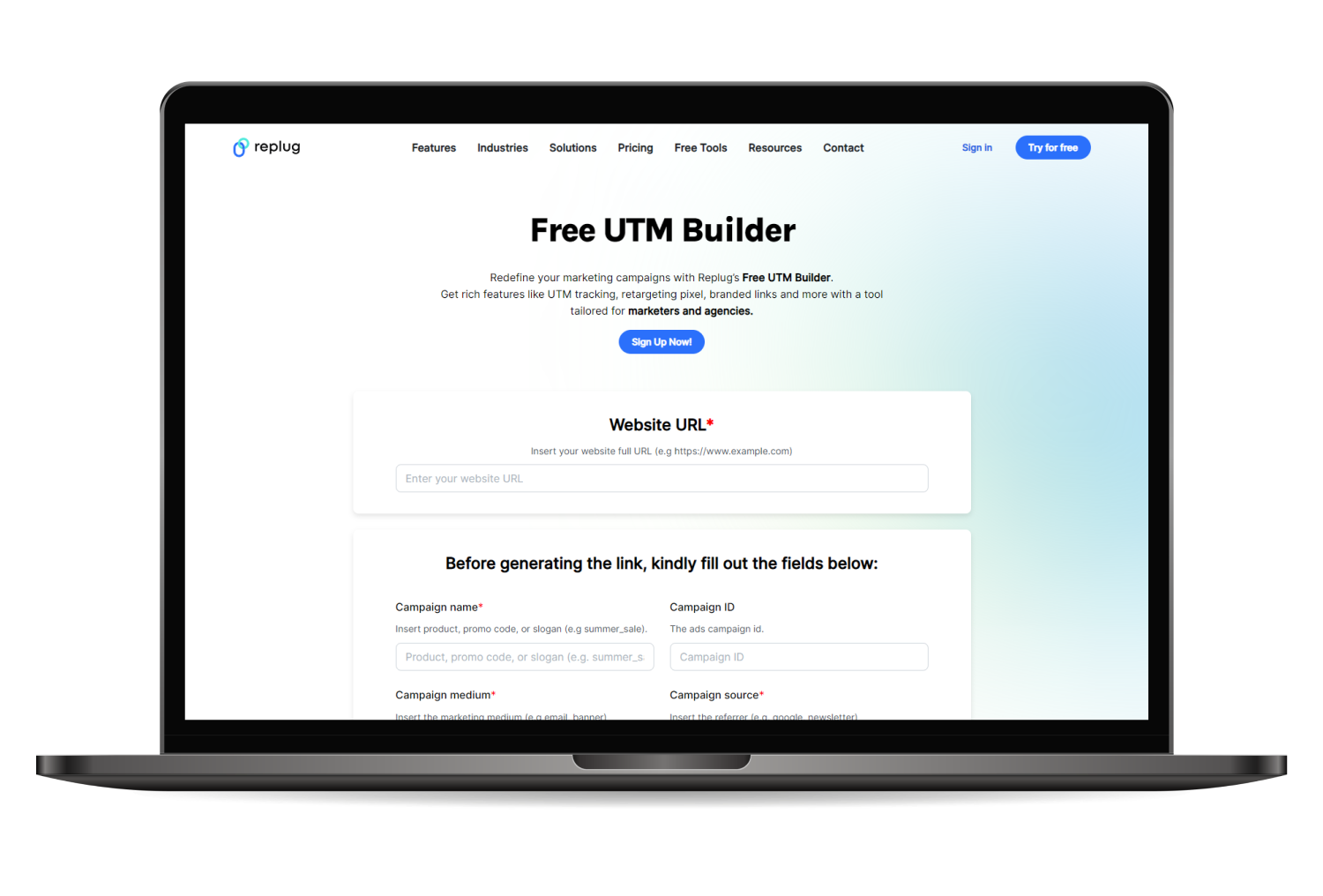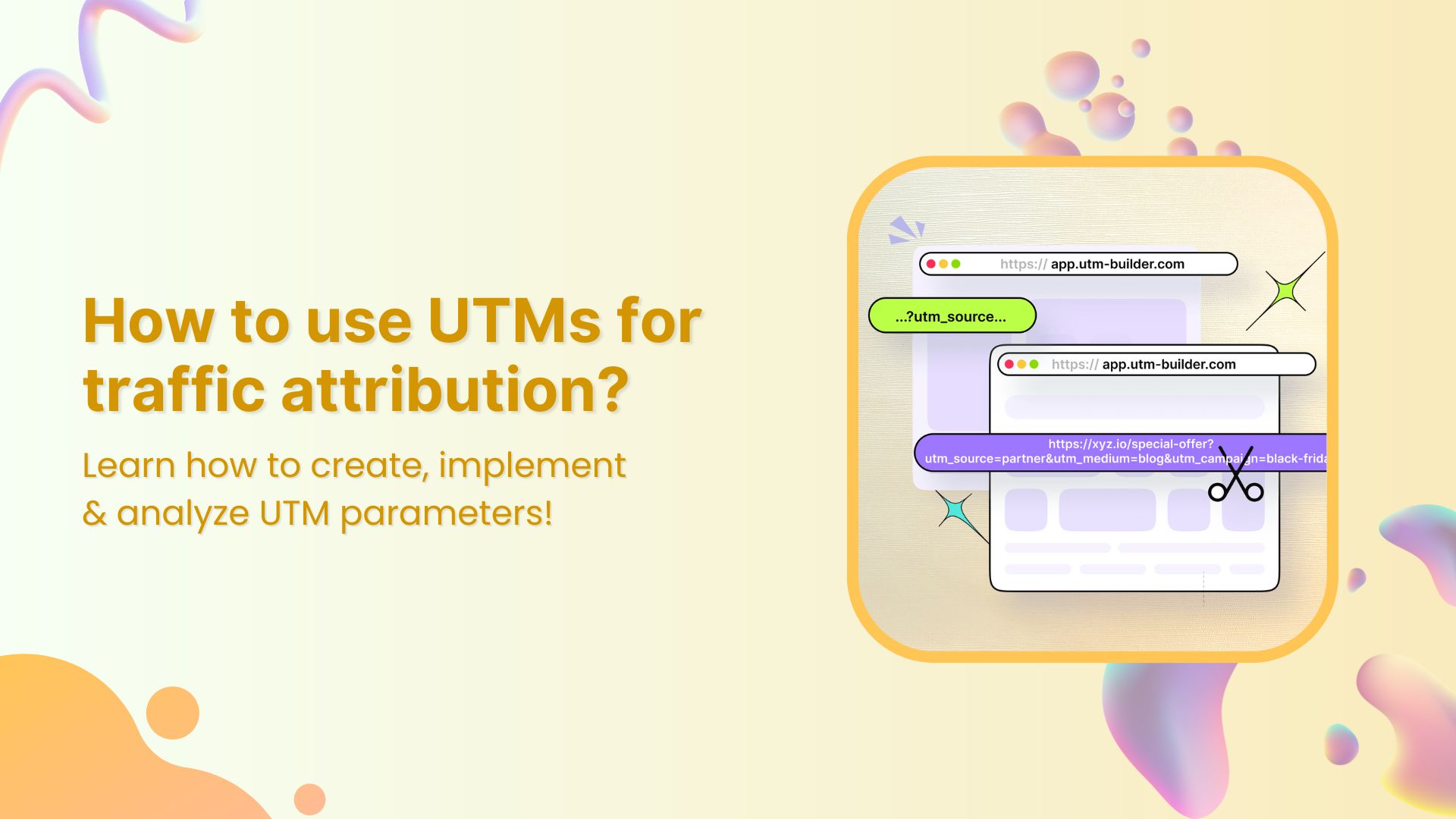UTM is a key topic in digital marketing, especially when discussing conversion optimization. And to optimize conversions to the fullest extent, it’s essential to employ best UTM practices, empowering marketers to make data-driven decisions that enhance campaign effectiveness.
If you ever noticed a long, clunky URL in the web browser after clicking on a CTA button, chances are, you have already seen UTM parameters in action.
Well, this piece is going to help navigate you in the right direction. Not only will it explain what UTM parameters are, but it will also guide you on how to use UTM parameters.
Before we hop on the UTM best practices to adopt, there are a number of things about UTM parameters that need to be discussed.
Let’s roll!
UTMs explained: What are they?

UTM parameters are tags that record, monitor, and report user behaviors, actions, and performances on websites and blogs.
These are basic tracking codes in the conversion optimization process that help marketers, agencies, and bloggers understand the visitors’ activities and actions on the website.
More importantly, the purpose of adding UTM parameters to links, CTAs, and internal links is to capture the clicks and engagement for analysis.
Link Management Made Easy
Your go to link management tool for CTAs, branded and bio links, QR Codes, tracking and retargeting.
Get Started for FREE!
Why are UTM parameters so valuable?
E-commerce sites, marketing agencies, pro-bloggers, and social media influencers use UTM parameters on their websites, blog posts, landing pages, and email funnels. The purpose of using the UTM parameters is to track user behavior across different different areas.
Here are some of the main reasons why UTM parameters are crucial to a business:
i. Differentiates traffic coming from multiple sources
Multiple campaigns are a normal tactic to implement when trying to grow a brand or keep up with the market. A huge challenge is to understand the sources of the traffic.
UTM parameters can assigned to different marketing campaigns to easily identify all the relevant traffic sources, such as email newsletters, Facebook ads, Twitter posts, etc.
When the website traffic sources aren’t identified properly, it gets difficult for business owners to calculate the ROI on the marketing campaigns.
ii. Assists in labeling every digital marketing campaign
Since a digital marketing campaign has several areas, such as organic social media, social media ads, email newsletter, website, landing pages, and blog posts, it’s vital to have a system in place that quickly identifies every single website visitor or action.
UTM parameters massively help in labeling the specific digital marketing campaign without putting a lot of human resources into it.
The main purpose of adding UTM parameters to the CTAs and links is to assign different tags that help marketers understand the traffic source and UTM placement.
iii. Recognizes the focused campaign platform
Social media marketing isn’t usually based on a single social media platform. However, it’s good to use customized credentials for each social media marketing campaign.
One of the reasons why UTM parameters are worth using is that they assist users in creating a focused plan according to the platform.
For instance, if you’re creating multiple campaigns for Facebook, such as Facebook ads, Facebook organic, and Facebook sponsorship, you can mention the different source, and medium, and type in the UTM parameters to understand the campaign well.
iv. Identifies call-to-actions that drive more conversions
Identification of the call-to-action that drives more conversions gives users a bird-eye view of their call-to-action real estate.
When a user is using different UTM parameters across all call-to-actions on the website, it’s easier this way to find out the best-performing CTA.
All it takes is to calculate the total conversions and see what UTM parameters brought in more sales.
Related: Boost Your ROI with Personalized Call to Action for a Website
v. Helps track campaign performances
One of the reasons why UTM parameters are valuable for any digital marketing campaign is that they provide a tracking facility to the marketer.
The performance analysis is crucial to understanding how strategies are working out. It gives marketers a chance to evaluate the tactics and pivot if it’s required.
You may also like: How to use UTMs for marketing attribution?
UTM best practices & tips to apply
Let’s discuss UTM best practices that no one can afford to miss out:
i. Understand both basic & custom UTM parameters

The first UTM best practice is to use the appropriate UTM parameters. Since most marketers know about the basic UTM parameters, but it’s also important to know how and where to use them.
For instance,
- utm_campaign should be used for the campaign names.
- utm_source should be used for the platform or website, etc.
Custom UTM parameters can be tailored to track specific elements of your marketing campaigns beyond the standard parameters.
It’s best the use the custom UTM parameters when they bring more clarity and help distinguish the performance in the reporting.
For instance,
- &influencer=joshadams
- &geo=nyc
- &agency=rightaways
Pro tip: Ensure the parameters aren’t being used interchangeably. Otherwise, it will create troubles in reporting and analyzing the data.
ii. Be Consistent with tagging
Consistency is key in UTM tagging. Stick to a consistent naming convention for all your parameters. This helps in avoiding discrepancies in data analysis.
Decide on lowercase or uppercase, use of underscores vs. dashes, and stick to it to avoid confusion (e.g., utm_source=facebook vs. utm_source=Facebook can result in two separate entries in analytics platforms).
Pro tip: Ensure consistency in UTM usage across all platforms by using a centralized management tool or platform-specific guidelines. This avoids discrepancies in how campaigns are tracked across different channels and platforms.
iii. Use descriptive values
Make sure the values assigned to each UTM parameter are descriptive and provide clear information about the source, medium, and campaign. This helps in easily identifying the campaign elements in your analytics reports.
For example:
- utm_source =
google,newsletter - utm_medium =
cpc,email - utm_campaign =
spring_sale,2024_launch
iv. Keep a record of the UTM generation
Creating a master spreadsheet for keeping a record of the UTMs created across different campaigns. This is particularly useful for large teams to ensure everyone uses the correct parameters and understands the ongoing strategies.
However, new team members might find it difficult to understand the spreadsheet unless they get proper training on UTM management.
Moreover, marketing teams can take the UTM recording to the next level by adding performance metrics to the spreadsheet.
This documentation should include the full URLs used, shortened URLs, the purpose of the campaign, metrics and the date.
v. Limit the number of parameters
It’s wise to know when and where to use the UTM parameters. One must know that the UTMs are not intended for tracking organic searches, emails initiated by users, links shared organically in messaging apps, or social media posts made by the general public.
A core reason is that these platforms offer limited control over tracking. While some individuals attempt to label organic traffic, the resulting data remains both incomplete and unverifiable.
vi. Leverage browser extensions
Use browser extensions designed for UTM management. These can help you quickly generate UTM-tagged URLs, save commonly used templates, and even track the performance of various parameters without needing to switch back and forth between tools.
vii. Shorten the long URLs
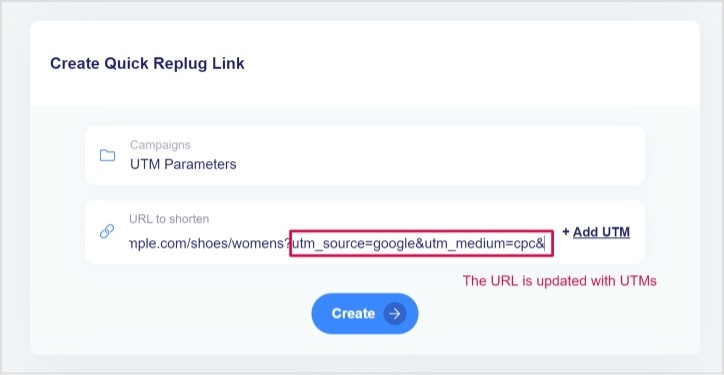
One of the UTM best practices is to always shorten the long and hefty UTM links in a social media or email marketing campaign.
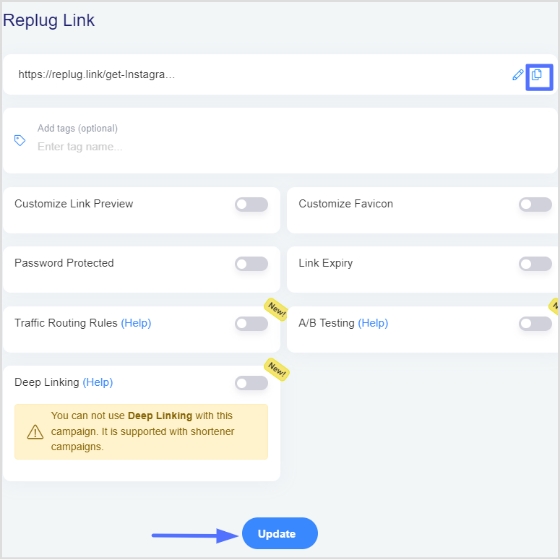
Long URLs with many UTM parameters can be unwieldy and unattractive.
Use a powerful URL shortener to shorten the URLs, and it even allows to shorten UTM links.
Replug is a robust link management tool that offers several rich features to cater to your online branding and marketing needs.
Pro tip: Ensure that your links are mobile-friendly and UTM tracking codes persist across different platforms, helping to maintain accurate tracking as users switch devices.
viii. Use a good UTM parameter builder
Adding UTM parameters gets easier when a user has an accurately written UTM parameters code to insert into the URL. There are several UTM code generators available on the market. All users have to do is input their data and press generate to create the UTM parameters code.
ix. Track UTM code performances
URL analysis is essential to any digital marketing campaign – UTM parameters are no different.
So, the next best UTM practice is to track UTMs to gather precise analytics about traffic sources and campaign effectiveness. By analyzing this data, marketers can optimize their strategies and improve ROI. Additionally, consistent UTM parameters ensure that data across various platforms remains accurate and comparable.
Try using Usermaven for tracking the UTM parameters.
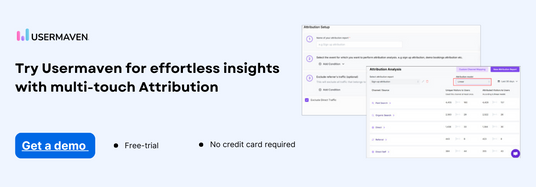
Pro tip: Regularly review historical UTM data to identify trends or patterns over time. This can provide insights into the long-term effectiveness of different sources or campaigns, and help in planning future marketing strategies more effectively.
x. Maintain a clear UTM parameter hierarchy
For complex campaigns, such as those involving multiple products or regions, use a hierarchical structure in naming that can be easily decoded.
For instance:
- utm_campaign=2024Q1_US_NY_ProductA_Promo
This structured approach helps in segmenting the data more effectively in analytics tools and makes manual sorting and filtering more manageable.
xi. Leverage UTM parameters for email segmentation
In email marketing, the best UTM practice is to segment users based on interaction with previous campaigns.
For example, you can track which segments are more engaged and target them with specific content or offers based on their past interactions.
Related: How to track emails using UTM parameters?
xii Utilize UTM parameters for A/B testing
Another best practice for UTM parameters is to distinguish between different versions of a campaign in A/B testing scenarios. By altering the utm_content parameter, you can track how different headlines, images, or calls to action perform without confusing them with your regular campaign data.
Pro tip: Experiment with different types of content by tracking their performance through UTM parameters. This can include varying the content type, style, or delivery platform to see what resonates best with your audience.
viii. Regularly update UTM parameters
To keep your campaign tracking relevant and actionable, periodically review and update the values used in UTM parameters. This includes retiring values that are no longer in use, updating terms to reflect current marketing language, and ensuring that all parameters are aligned with current business goals and strategies.
Pro tip: For campaigns that are repeated or recycled (like annual promotions), update the UTM parameters to reflect the new dates or other relevant changes. This prevents old data from being mixed with new data.
xiv. Automate where possible
To reduce human error and save time, automate the generation of UTM parameters where possible. Use scripts or specialized marketing tools to append the correct UTMs to URLs based on predefined rules and templates.
xv. Use UTM parameters beyond the web
While UTM parameters are commonly used to track URL traffic & sources, but they can also be effectively used in offline scenarios.
For instance, you can include QR codes in print ads, where the QR code URL contains UTM parameters. This helps bridge the gap between offline and online campaigns, providing insights into how your offline efforts are contributing to online traffic.
Pro tip: In dynamic advertising environments (like PPC), use scripts to adjust UTM parameters based on the ad placement, viewer demographics, or interaction history. This dynamic allocation can greatly enhance the granularity and relevance of tracking data.
Best tools for UTM management
Below are the best tools for creating, managing and tracking UTMs.
i. Replug
Shorten your links, amplify your brand.
Create shareable, trackable and fully customizable branded urls. Get more clicks with absolute link management features such as Bio Links, retargeting, deep Links, CTA’s and more.
Learn More!
- Key Features: Replug is a popular link management platform that offers UTM tagging functionality alongside link shortening, bio link, retargeting and tracking features.
- Benefits: User-friendly interface, real-time link tracking and analytics, customizable link previews, and easy sharing options.
- Access: Free trial and paid plans available, with additional features in premium plans.
ii. Usermaven

- Key Features: Usermaven allows you to track custom URLs with UTM parameters for tracking campaign analytics.
- Benefits: Simple and privacy-friendly analytics tool, allows to track UTM parameters effortlessly, enhances marketing campaign performance, provides insightful user engagement metrics and much more.
- Access: Free trial available, accessible on all browsers.
iii. ContentStudio

- Key Features: With ContentsStudio, you can add UTM parameters to your posts with saved presets or generate fresh ones as needed.
- Benefits: Streamlined social media scheduling and publishing, comprehensive analytics for social campaigns.
- Access: Subscription-based pricing with a free trial available.
Pro tip: If you’re using CRM software, email marketing platforms, or other analytics tools, ensure UTM data is integrated wherever possible. This provides a holistic view of how different channels and campaigns contribute to your business goals.
4 mistakes to avoid while creating UTMs

i. Avoid using special characters
Special characters in UTM parameters (like commas, spaces, and symbols) can sometimes break URLs or cause tracking issues.
Stick to alphanumeric characters and dashes or underscores if needed. This keeps URLs robust and avoids issues with browsers or analytics platforms misinterpreting the data.
ii. Avoid sensitive information
Do not include sensitive or personally identifiable information in UTM parameters. Since URLs with UTM parameters can be shared widely and remain visible, including sensitive data can lead to security and privacy issues.
You may also like: URL Hijacking: A Complete Guide to Protecting Your Online Presence
iii. Avoid formatting errors
Formatting is crucial to writing down the UTM parameters correctly. Mistakes, such as adding spaces or backslashes may create trouble. Use the default formatting to avoid discrepancies and inconsistent outcomes.
Underscores and signs often serve as alternative substitutes for spaces. Underscores are well-utilized when two words are put together and read as one.
For example, utm_campaign=high-calories_drinks means you’re discussing high-calorie drinks in the campaign.
iv. Avoid redundancy
Make sure there is no redundancy in the information provided by UTM parameters. For example, if utm_medium is ‘email’, there’s no need to include “email” again in utm_source or utm_campaign. This will keep URLs cleaner and focus your analysis on distinct data points.
How to use UTMs to track everything
UTMs are a great way to track URL performance, user actions, consumer behavior, and visitor clickability on the site. There are many areas in the digital marketing space where UTMs have been effectively used for the past several years. Here are some of the key places to use UTM parameters:
a. Email marketing – UTM parameters can be used to track open rate, conversion, and clickability in email newsletters.
b. Social media – Ads, organic posts, and sponsored posts can be monitored by adding UTM parameters to the URLs
c. PPC ads – Pay-per-click ad campaigns are incomplete with you putting the URLs in the ads. Inject UTM parameters in the destination URL for analyzing performance
d. Influencer marketing – Influencer marketing is a powerful yet underpriced marketing strategy. Add UTM parameters to the URLs mentioned in the affiliate marketing campaign
e. Affiliate marketing – affiliate marketing also uses product links to get clicks and conversions.
You may also like: How to use UTM parameters for traffic attribution?
Key steps to follow to track UTM parameters
Let’s uncover how to use the UTM parameters to track URLs across different areas:
i. Define your strategy of using the UTM parameters
UTM parameters aren’t just about adding the UTM tags to the URLs. It’s just a tiny section of the process. The first and foremost part of the process is the planning.

To effectively leverage UTM parameters for tracking, it’s crucial to first define a clear strategy. Determine your key metrics, campaign goals, and the specific data you aim to collect using UTM parameters.
Once a clear strategy map is drawn, anybody on the marketing team can use it to implement the strategy or take charge of the campaign and lead it further.
ii. Choose a UTM builder to create UTM parameters
Once a clear and suitable UTM parameters strategy is in place, the next up is the selection of a UTM builder that provides updated, traceable URLs.
Therefore, choose a reliable UTM building tool. These tools streamline the process of creating UTM parameters by providing user-friendly interfaces and ensuring consistent formatting for accurate tracking.
Several free tools on the marker make it conveniently easy for marketers and conversion experts to add UTM parameters to the URLs.
iii. Implement the UTM tracking codes
Once you have established a UTM strategy and chosen a suitable UTM builder, the next up is the implementation process. Most UTM builders offer a quick process of implementing the UTM parameters to the URLs.
All users have to do is to provide the UTM, select the parameters, and hit the button to generate the required URLs.

Once the UTM parameters are implemented, the user can add the URLs to the campaign. The marketer must ensure that each parameter accurately reflects the source, medium, campaign name, and other relevant details to maintain data integrity and enable comprehensive analysis.
iv. Analyze the UTM tracking URLs
Tracking URL performance is crucial in the digital marketing campaign. Once UTM parameters are deployed on the links across various channels, it’s essential to regularly analyze the collected data.

Use a tool like Usermaven to gain insights into the performance of your campaigns, assess the effectiveness of different channels, and optimize future marketing efforts based on the findings.
That’s how any brand or marketer can use the UTM parameters to track everything.
FAQs About UTM Parameters
Let’s take a look at some of the commonly asked questions about UTM parameters:
What are the 5 things you can track with UTM parameters?
1. PPC ad’s clickability
2. Social media links performance
3. Email newsletters performance
4. Affiliate marketing results
5. Influencer marketing campaign
How do you organize UTM parameters?
Analyze the UTM parameters’ performance using a powerful link management tool like Replug or use a website analytics tool like Usermaven to keep track of the URL’s performance.
Once a URL tracking tool is in place, you can use a Google spreadsheet to keep a record of the UTM parameters’ performance.
Do UTM parameters have to be in order?
The UTM parameters don’t necessarily need to be in a specific order. However, the tags must be correctly written to work. There shouldn’t be any syntax errors that hinder the tracking and reporting processes.
Which platform is used to track UTM parameters?
You can use Usermaven to track UTM parameters. However, there are many other tools to analyze the URLs and track UTM parameters that can also be used for the same purpose.































